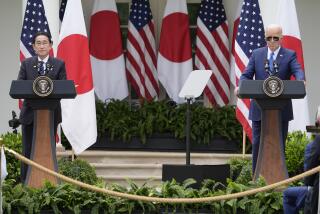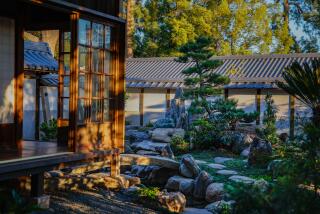THE SUMMIT IN TOKYO : Conference Site Bears Few Reminders of the Far East: It’s a Miniature Versailles
- Share via
TOKYO — An opulent palace designed to “Westernize” Japan’s Imperial Family--over the objections of Emperor Hirohito’s father and grandfather--will provide a very non-Japanese setting for the economic summit conference opening today.
The old Akasaka Detached Palace, now called the Geihinkan (Guest House), is a billion-dollar monument to Japan’s rush to Westernize itself and win acceptance abroad at the turn of the century. The official guest house will offer virtually no reminders that the delegates are in Tokyo.
If the leaders of the United States, Britain, France, West Germany, Italy and Canada look closely before entering the building, they will see two samurai-like bronze statues and two definitely non-European mythological birds perched on the roof over the entrance. But inside, the Guest House is strictly 17th- and 18th-Century European.
France’s President Francois Mitterrand and Premier Jacques Chirac ought to feel particularly at home. The lavish building is a reproduction of the Versailles Palace but much smaller.
Shortage of Toilets
So perfect was the copy that until a massive six-year renovation was finished in 1974, only six toilets--all in the basement--could be found in the 300-room building because Versailles had only that many. A European fear that toilets spread disease, a concern never shared by the Japanese, accounted for the scarcity at Versailles.
The main steel gate was made in France, and other materials were gathered from all over the world: marble from Italy, rugs from England, reinforcing steel from Pittsburgh. The palace withstood the Great Kanto Earthquake of 1923 without damage.
Kakuei Tanaka, who as prime minister dedicated the refurbished building in 1974, called it “a state guest house without parallel in the world.”
Including the land, the value of which was estimated at $596 million in 1974, the palace is worth far more than $1 billion today. The artisans who created the painted ceilings, the wood-paneled rooms with cloisonne paintings of flowers and birds, the carved walls, are no longer to be found, and this probably makes the building priceless.
When it was built, starting in 1899, it cost 5,105,572 yen (the equivalent of $555.6 million in 1986 prices). Renovation from 1968 to 1974 cost $61.1 million, and a refurbishing in 1979, for one of the earlier economic summit conferences, cost $2.8 million.
The budget for additional renovations for this year’s conference has not been made public, but new carpeting and wiring for microphones have been installed in the two 250-square-yard halls that will be the main conference rooms.
Emperor Mutsuhito, who after his death was called the Emperor Meiji (after the era in which he ruled, from 1868 to 1912), objected to construction of the palace. The expense, he complained, was too great a drain on Japan’s treasury, particularly in light of the 1894-95 war with China and the 1904-05 war with Russia.
Emperor Appalled
Most of all, the grandfather of the current emperor, Hirohito, was appalled by the Western style of the palace, which was designated as the official residence for crown princes. The government, in its rush to Westernize, ignored the objections.
It is said that Mutsuhito never set foot in the palace. And he declared that his son, Crown Prince Yoshihito, who was to assume the posthumous title of Emperor Taisho, need not live “in that place.” Yoshihito stayed in a Japanese-style residence.
Only Hirohito lived in it, from 1923 until 1928, when his investiture ceremony was held two years after he assumed the throne on the death of his father. It was his home in the early days of his marriage to Empress Nagako, whom he wed in 1924.
The five years during which Hirohito lived in it were the only period of full use by royalty.
It was not used at all until Prince Edward of England (later King Edward VI and, upon abdication, the Duke of Windsor) stayed there during a visit in 1922. After Hirohito and Nagako moved to the Imperial Palace, it was virtually empty for 17 years. It was unoccupied from 1965 to 1974.
After World War II, by order of U.S. occupation forces, its ownership was transferred from the Imperial Household Agency to the national government. Common citizens started touring it on a daily basis as it was used successively as the National Parliament Library, as offices for an administrative reform commission and as headquarters of the 1964 Olympic Organizing Committee. It also served to house an impeachment court.
A visit by West German Chancellor Konrad Adenauer spurred Japanese leaders to refurbish the palace as a permanent guest house.
Splendor returned in November, 1974, when King Baudouin and Queen Fabiola of Belgium were guests. Later that month, President Gerald R. Ford became the first political leader to stay in it. Since then, it has been used to lodge or entertain foreign visitors on 89 occasions.
Prime Minister Yasuhiro Nakasone will provide his guests with a touch of Japanese atmosphere by entertaining them at lunch Monday in an annex, which was put up as part of the 1968-74 renovation.
The annex has floor-to-ceiling windows that open out on a Japanese garden with a carp-filled pond. With its central tatami (straw-mat) dining room, it is as subtle and simple as the palace is opulent and overpowering.
Its 40-square-yard lobby has a single adornment: a six-inch flower vase on one wall. In the dining room, the only decorations are a scroll and a flower display.
Two compromises were made for foreigners. Guests sit around a table only a foot above the floor, but there is a recess that permits diners to sit upright without folding their legs Japanese-style. Door frames allow guests as tall as 6 feet 4 inches to pass through without bumping their heads.
None of the summit conference delegates will be staying at the palace. Although it contained 300 rooms as designed, it now can accommodate only 36 guests.
The next guests to be lodged there will be Britain’s Prince Charles and Princess Diana, who will arrive in Tokyo on Saturday for a three-day stop.
More to Read
Sign up for Essential California
The most important California stories and recommendations in your inbox every morning.
You may occasionally receive promotional content from the Los Angeles Times.













